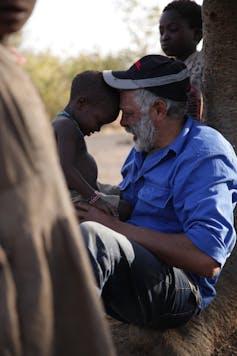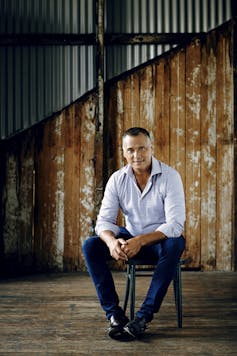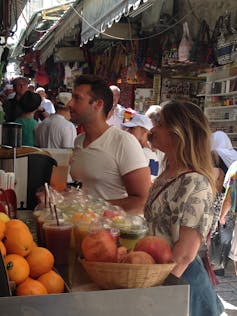The first episode of the long awaited SBS series DNA Nation screened on Sunday night. In between ads enticing the viewer to part with cash for the chance to be told they descend from a Viking or a Polynesian princess (free shipping if you order now!), we watched Ian Thorpe, Julia Zemiro and Ernie Dingo have their DNA sampled by a geneticist in a white coat and embark on an epic journey across the globe in the steps of their distant ancestors.
The premise is fantastic, and judging by the first episode, production company Blackfella Films has struck the right balance between sweeping landscapes, laboratory shots, Colin Friels’ authoritative narration of the science and Julia Zemiro’s facial expressions.
Tanzania is the backdrop of much of the episode, with the three stars mingling with the Hadza people who, we are told, are the direct descendants of the first Homo sapiens to evolve.
As the first episode closed we watched our intrepid travellers walk out of Africa, just like their ancestors some 50 000-100 000 years ago. From there, we are told, the three will part ways, each on their individual genetic journey. The suspense will entice many viewers back to see episode two, but others will be left with unanswered and uneasy questions.
How African is Ernie?
First things first. The focus on the Hadza as living-ancient-people that can reveal our inner nature was low-hanging fruit for critics of popular science, or for that matter, anyone with an Arts degree.
The whole point of flying three famous Australians to Tanzania is that we are all descended from Africans, not just the Hadza. Over the last 200,000 years, the humans that became the Hadza have changed and evolved, just as much as people who now identify as Slovenian, Japanese or Indigenous Australian.
I’m sure the Tanzanian tourism board and the Hadza appreciate the attention, but it is not good anthropology or good science.

We glimpsed the even bigger questions that DNA Nation glosses over when our man-in-a-white-coat skyped into Africa to reveal how much African DNA each of our three protagonists carried in their cells.
Ernie, Julia and Ian are all descendants of the humans that left Africa between 50 000 and 100 000 years ago to populate the rest of the world. So, unsurprisingly, each of them is the same amount of African – not very much.
Julia was visibly shocked that Ernie was not more African than she or Ian, since he has brown skin and effortlessly bonded with Hadza children, telling them the names of body parts in his Aboriginal language.
It is great to see Julia, and hopefully many viewers, replace their assumptions that “all brown people must be genetically similar” with a better understanding of science.
In fact, because all humans with recent ancestry outside Africa descend from a relatively small number of pioneers who left the continent, non-Africans have much less genetic diversity than Africans.
Julia and Ernie are likely to share more genetic code than two Africans would. But beyond correcting misconceptions, a-ha moments like these raise tougher questions about potential conflicts between western and Indigenous approaches to knowledge.
Genetics and Indigenous identity
Viewers had to switch channels to Stan Grant’s NITV talk show The Point directly after DNA Nation for an airing of the tricky issues.
For instance, does the idea that everyone comes from Africa undermine the land rights of Indigenous Australians? The panel didn’t provide a clear answer, but we can: it doesn’t.

There is no sign that evolutionary science is eroding Indigenous rights in this country. In fact, genetic research into human origins is pushing the date of Indigenous occupation of Australia back further and further.
Could genetic ancestry testing ever be used by Aboriginal organisations, governments or courts to prove or disprove Aboriginality?
Indigenous ancestry is part of Indigenous identity, but other aspects – far beyond the reach of genetics – are just as crucial to Indigenous people, including cultural knowledge, community acceptance and connection to country.
The role of genetics in identity will now be a hot topic of debate, with a diversity of views among Indigenous people. Palawa elder Rodney Dillon, for example, argues that genetics could potentially resolve long running and damaging disputes about Aboriginality within his own Tasmanian community.
In working through the issue, we should keep in mind that Australia has so far avoided the divisive politics of inclusion and exclusion that mar so many Indigenous groups in the United States (and more recently, in Canada), and we shouldn’t let anything change that.
Forget the can – genetics is a barrelful of worms. Indigenous people have known this for a long time, at least since the 1990s.
It was then that the Human Genome Diversity Project, widely known as the “Vampire Project”, sought to sample genetic diversity from Indigenous people around the world. It was a public relations disaster, with little or no consultation with Indigenous groups before it started.
The Central Australian Aboriginal Congress called the project “legalised theft” of Indigenous genetic material. The reputation of genetic research among Indigenous groups went from bad to worse for the coming generation.
Genomics is everywhere
Fast forward two decades, and genomics seems to be everywhere. The massive acceleration in sequencing technology means that your genome will soon be an indispensable part of diagnosing and treating a wide range of diseases (and is already used for some conditions).
We are moving to an era of personalised medicine which may have real health benefits for Indigenous peoples. Getting “your DNA done” through a direct-to-consumer genetic testing company is increasingly common, and Indigenous Australians are among those paying up to learn about their genetic ancestry and possible health risks.

Aside from the political and ethical problems we have touched on here, there are also technical concerns with the genetic testing industry for Indigenous Australians.
For Indigenous viewers of DNA Nation who are inspired to trace their own genetic ancestry, the single company that offers Australian Aboriginal testing is the US based DNA Tribes.
Rather than the conventional method of maternal (mitochondrial DNA) and paternal (Y chromosome) testing used on DNA Nation, they use sections of DNA called single tandem repeats (STRs) that vary in the number of copies each person has.
DNA Tribes compare customers’ 23 pairs of chromosomes with databases from around the world, including Australia. The problem is that these are forensic databases appropriate for forensic casework and paternity testing, but not genetic genealogy.
We don’t know what “reference samples” DNA Tribes are using for Indigenous Australians or whether informed consent was given for the use of this data for commercial purposes.
While it is clear that there is not, and never will be, a genetic test for Aboriginality, advances in genomics will have flow on effects for identity and culture that need wide discussion.
Flow on effects for identity
Indigenous Australians should be able to access the potential benefits of ancestry testing, such as it helping with family reconnection, and shouldn’t miss out on the potential health benefits of genomics. That’s why we need to face the tough questions raised by genetics for Indigenous people, however thorny they may be.
The only certainty here is the importance of full Indigenous engagement in every aspect of genomic science, from the start to the finish.
That’s the approach we take at the National Centre for Indigenous Genomics. The first Indigenous-governed genome facility in the world, NCIG began when the Australian National University developed a management strategy for 7,000 blood samples collected from Indigenous communities, mostly in the 1960s and 70s.
At our centre, we will be listening carefully to the difficult conversations that DNA Nation will stimulate.

